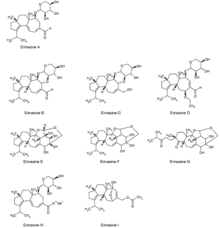
Chemical structures of erinacines A-I
Erinacines are natural substances isolated from Hericium erinaceus. They belong to the group of cyathin diterpenoids (erinacines A-K, P, and Q) and are subjects of pharmacological research.
Erinacine A
Erinacine A, isolated from the cultured mycelia of Hericium erinaceus, the main representative of this compounds group, has an enhancing effect on nerve growth factor synthesis in vitro.[1] It also increases catecholamine in the central nervous system of rats.
Erinacine A has also been prepared by total synthesis.[2]
Erinacine E
Erinacine E is a kappa opioid receptor agonist.[3]
References
- ↑ Hirokazu Kawagishi; Atsushi Shimada; Ryoko Shirai; Kenji Okamoto; Fumihiro Ojima; Hideki Sakamoto; Yukio Ishiguro; Shoei Furukawa (1994). "Erinacines A, B and C, strong stimulators of nerve growth factor (NGF)-synthesis, from the mycelia of Hericium erinaceum". Tetrahedron Letters. 35 (10): 1569–1572. doi:10.1016/S0040-4039(00)76760-8.
- ↑ Barry B. Snider; Nha Huu Vo; Steven V. O'Neil & Bruce M. Foxman (1996). "Synthesis of (±)-Allocyathin B2 and (+)-Erinacine A". J. Am. Chem. Soc. 118 (32): 7644–7645. doi:10.1021/ja9615379.
- ↑ Saito T, Aoki F, Hirai H, et al. (November 1998). "Erinacine E as a kappa opioid receptor agonist and its new analogs from a basidiomycete, Hericium ramosum". The Journal of Antibiotics. 51 (11): 983–90. doi:10.7164/antibiotics.51.983. PMID 9918390.
Further reading
- Kenmoku H, Shimai T, Toyomasu T, Kato N, Sassa T (March 2002). "Erinacine Q, a new erinacine from Hericium erinaceum, and its biosynthetic route to erinacine C in the basidiomycete". Bioscience, Biotechnology, and Biochemistry. 66 (3): 571–5. doi:10.1271/bbb.66.571. PMID 12005051. S2CID 46327735.
This article is issued from Wikipedia. The text is licensed under Creative Commons - Attribution - Sharealike. Additional terms may apply for the media files.